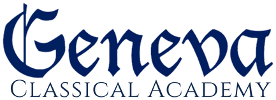What’s the Difference: Geneva’s Curriculum is Integrated
Most contemporary Americans’ high school education consists of “subjects”: math, science, English, and history. These subjects are taught by teachers who know their individual disciplines. For example, in Algebra class, students learn mathematical terms, how to solve equations, and graphing; in Civics, students study the War for Independence, the Constitution, and the three branches of government; English students are taught to write complete sentences with subject and verb agreement, proper modifiers, and punctuation, while reading some interesting fiction and poetry.
The problem in these compartmentalized subjects is this: equations have nothing to do with history; punctuation is irrelevant to the Constitution; and Thomas Jefferson is disconnected from Greek city-states. Perhaps most regrettably, morality and ethics are not part of the curriculum; whether or not the colonists should have fought the war against Britain is never addressed. The modern high schooler learns how to study for tests and subsequently forgets the material because it is not needed again. The result is that each subject is an air-tight compartment from the next, never overlapping or relating.
David Hicks describes the mainstream school experience when he says in his book, Norms and Nobility, “Whatever [the modern educator’s] reasons for rejecting the classical curriculum, his classrooms suffer from its absence in three notable ways. In them, human experience tends to be dealt with narrowly and reductively, broken down into isolated, unconnected units; students ignorant of what questions to ask are presented with uninvited and consequently meaningless information; and there is no basis for making moral and aesthetic judgments or for attaching learning to behavior.”
Modernistic and secular education is missing a very important component, one which classical and Christian education provides: integration. Contemporary education is the outworking of a philosophy that views everything as a machine through which science teaches us to dissect, looking for how things are made. The problem with this approach to education is identified in William Wordsworth’s poem, “The Tables Turned”:
Sweet is the lore which Nature brings;
Our meddling intellect
Mis-shapes the beauteous forms of things:–
We murder to dissect.
“We murder to dissect.” In other words, the compartmentalization of subjects is a dissection and without a synthesis, a bringing back together, the subject dies and beauty is lost. What a tragedy!
Classical education, on the other hand, seeks not only to take things apart to see how they work but also to bring them together again. The Socratic method breaks ideas, information, and subjects down to see how the constituent parts relate, and then it brings them back together to discover how the learner can apply the lesson as well as what people ought to do.
All school subjects are related, and a classical teacher helps the student to discover the connections in two ways: concepts within subjects and concepts between subjects. For example, Julius Caesar being assassinated in 44 B.C. is connected to Octavian becoming Caesar Augustus which has direct bearing on Virgil writing the epic, The Aeneid, which inspired Dante in his writing of the Divine Comedy. All of this has theological implications for Christianity, and furthermore, as Christians, we see all things in God’s world as related and under the Lord’s authority.
C.S. Lewis warned modernity in Abolition of Man “Perhaps, in the nature of things, analytical understanding must always be a basilisk (predatory lizard) which kills what it sees and only sees by killing. But if the scientists themselves cannot arrest this process before it reaches the common Reason and kills that too, then someone else must arrest it.” Geneva Classical Academy exists to arrest the disintegration taking place in education.

